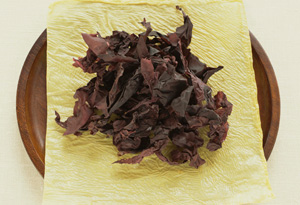Seaweed: Jewels of the Sea

Photo: Jupiterimages/Thinkstock
Perhaps calling them "seaweed" is a little derogatory. We think of "weeds" as undesirables in the plant kingdom—uninvited pests that sprout up in our lovely, manicured gardens. They can cost us hours of our precious time when extracting them to protect our pretty flowers from being tainted by their ugliness. They're the unruly students who can wreak havoc in the classroom of our "trained-to-behave" children. We certainly don't think of them as sources of nourishment or foods to adorn our plates at dinnertime.
Yet, I like to refer to seaweed as "jewels from the sea" because, in my world, they've been elevated to that level. Perhaps it's because they became my lifesavers at a time when I was destined to be dependent on medication for life for my thyroid problem. It was these humble jewels that came to my rescue, offering me the nutrition my body needed to keep my thyroid functioning without the medication. They promised to help me clear toxins from my body...and should I ever happen to be within earshot of a nuclear bomb (God forbid!), I would be protected from the fallout by mere fact that I was eating my daily dose of seaweed—this fact, according to my Japanese teachers, was documented after the bombing of Hiroshima.
Typically, we don't think of seaweed as this incredible, medicinal food. Rather, we think of it as the stuff that's around sushi, and for most of us, the story ends there. For myself, growing up in Ireland, my summer holidays were spent by the sea in Donegal. As children, we went foraging for dillisk, which drifted in from the sea and clung to the rocks around the shoreline. We picked the salty dillisk and left it to dry in the sun, which further concentrated the salty flavor. Then, we took it to my uncle's pub (which, by the way, was also the grocery shop, post office, drapery store and funeral undertakers), where they served it up in little bowls on the counter. It had the same effect as salty nuts or crisps that they often serve in bars—the salt encouraged more drinking, a clear demonstration of yin and yang in action!
There are many types of seaweed, or many jewels from the salty sea, each with distinct uses and benefits.
Get a list of the most common types of seaweed varieties, from nori to dulse
Yet, I like to refer to seaweed as "jewels from the sea" because, in my world, they've been elevated to that level. Perhaps it's because they became my lifesavers at a time when I was destined to be dependent on medication for life for my thyroid problem. It was these humble jewels that came to my rescue, offering me the nutrition my body needed to keep my thyroid functioning without the medication. They promised to help me clear toxins from my body...and should I ever happen to be within earshot of a nuclear bomb (God forbid!), I would be protected from the fallout by mere fact that I was eating my daily dose of seaweed—this fact, according to my Japanese teachers, was documented after the bombing of Hiroshima.
Typically, we don't think of seaweed as this incredible, medicinal food. Rather, we think of it as the stuff that's around sushi, and for most of us, the story ends there. For myself, growing up in Ireland, my summer holidays were spent by the sea in Donegal. As children, we went foraging for dillisk, which drifted in from the sea and clung to the rocks around the shoreline. We picked the salty dillisk and left it to dry in the sun, which further concentrated the salty flavor. Then, we took it to my uncle's pub (which, by the way, was also the grocery shop, post office, drapery store and funeral undertakers), where they served it up in little bowls on the counter. It had the same effect as salty nuts or crisps that they often serve in bars—the salt encouraged more drinking, a clear demonstration of yin and yang in action!
There are many types of seaweed, or many jewels from the salty sea, each with distinct uses and benefits.
Get a list of the most common types of seaweed varieties, from nori to dulse



